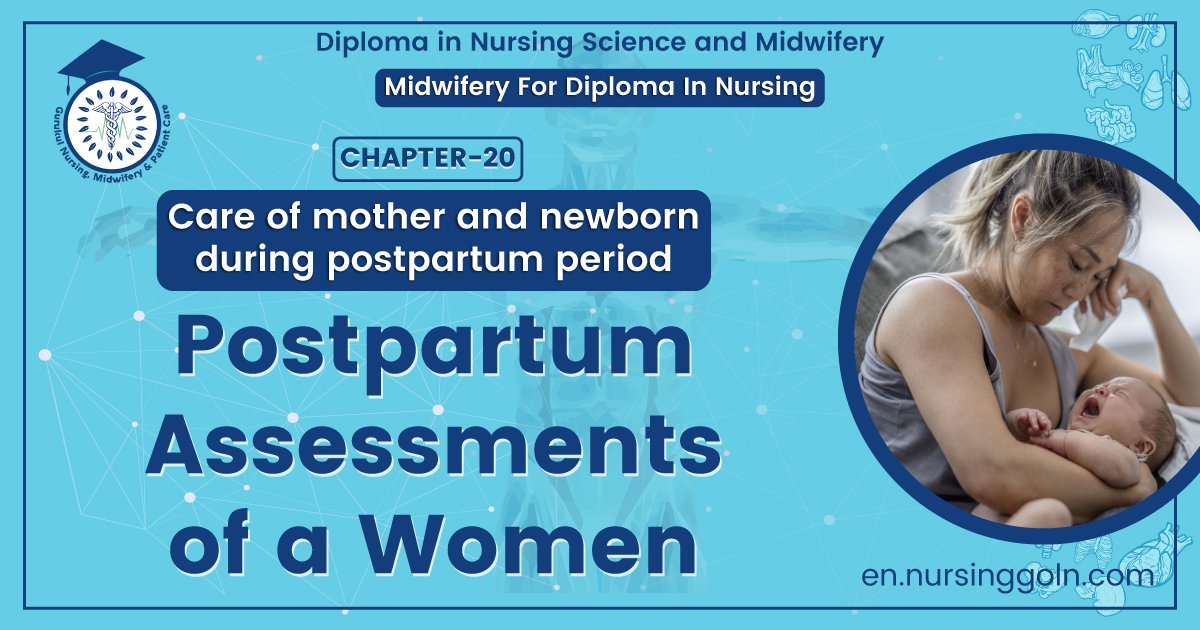Postpartum Assessments of a women – This course is designed to understand the care of pregnant women and newborn: antenatal, intra-natal and postnatal; breast feeding, family planning, newborn care and ethical issues, The aim of the course is to acquire knowledge and develop competencies regarding midwifery, complicated labour and newborn care including family planning.

Postpartum Assessments of a women
Initial Assessments
When caring for postpartum women, the nurse faces a high risk of contact with body fluids (colostrum, breast milk, and lochia from the mother as well as urine, stool, and blood from the infant). Therefore the recommendations of the Centers for Disease Control and Prevention (CDC) for standard blood and body fluid precautions must be followed diligently. Postpartum assessments begin during the fourth stage of labor (the first 1 to 2 hours after childbirth). During this time the mother is examined to determine whether she is physically stable. Initial assessments include:
a. Vital signs
b. Skin color
c. Location and firmness of the fundus
d. Amount and color of lochia
e. Perineum (edema, episiotomy, lacerations, hematoma)
f. Presence, degree, and location of pain
g. Intravenous (IV) infusion (type of fluid; rate of administration; type and amount of added medications; patency of the IV line; and redness, pain, or edema of the site)
h. Urinary output (time and amount of last void or catheterization, presence of a catheter, color and character of urine)
i. Status of abdominal incision and dressing, if present
j. Level of feeling and ability to move if regional anesthesia was administered
Chart Review
When the initial assessments confirm the mother’s physical condition is stable, nurses should review the chart to obtain pertinent information and determine if there are factors that increase the risk of complications during the postpartum period. Relevant information includes:
a. Gravida, para
b. Time and type of delivery (use of vacuum extractor, forceps)
c. Presence and degree of episiotomy or lacerations
d. Anesthesia or medications administered
e. Significant medical and surgical history, such as diabetes, hypertension, or heart disease
f. Medications given during labor and delivery or routinely taken and reasons for their use
g. Food and drug allergies
h. Chosen method of infant feeding
i. Condition of the baby

Postpartum Risk Factors
Hemorrhage
a. Grand multiparity (five or more)
b. Overdistention of the uterus (large baby, twins, hydramnios)
c. Rapid or prolonged labor
d. Retained placenta
e. Placenta previa or previous placenta accreta or abruptio placentae
f. Drugs (tocolytics, magnesium sulfate, general anesthesia, prolonged use of oxytocin)
g. Operative procedures (cesarean birth, vacuum extraction, forceps)
h. Uterine fibroids
i. History of postpartum hemorrhage
j. Preeclampsia
k. Coagulation defects

Infection
a. Operative procedures (cesarean birth, vacuum extraction, forceps)
b. Multiple cervical examinations
c. Prolonged labor
d. Prolonged rupture of membranes
e. Manual extraction of placenta or retained fragments
f. Diabetes
g. Catheterization
h. Bacterial colonization of lower genital tract
Read More.
